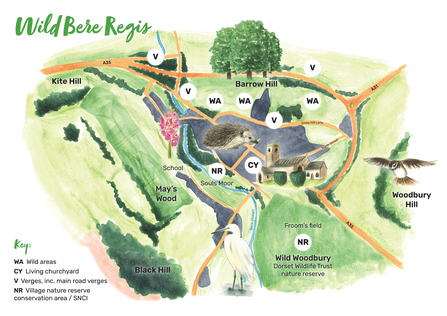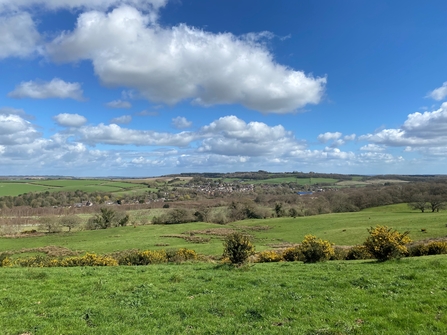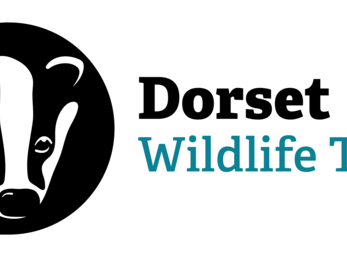Wild Bere Regis
Wild Bere Regis
The Bere Regis Wildlife and Environment Group is a sub-group of the Bere Regis Parish Council, formed after our involvement in producing a Parish Plan in 2007. Our views were taken into account in the development of the subsequent Neighbourhood Plan. As residents of Bere Regis we all appreciate and enjoy the surrounding countryside and the wildlife it supports.
We get involved in wildlife conservation across the parish, report to the Parish Council and work with the village Lengthsman who manages the village environment, making areas as good as we possibly can for wildlife.

Delphine Jones / Wild Bere Regis illustration
What is the landscape like around Bere Regis?
The Parish of Bere Regis follows the path of the Bere Stream from chalk downs to the north-west, through the sands and gravels around the village, to heathland in the south-east.
The village is set between four hills – Woodbury Hill, Black Hill, Barrow Hill and Kite Hill, which are superb areas of natural countryside and farmland surrounding the village. There are three designated Sites of Special Scientific Interest (SSSIs) - Black Hill, with Higher Hyde Heath and Tanpits Coppice to the south-east. There are also several Sites of Nature Conservation Interest (SNCIs) within the parish including our Souls Moor village nature reserve.
We now have an increasing number of nature conservation areas. May’s Wood, planted by Sir Brian May in 2013, provides a wildlife corridor right along the southern edge of the village, linking to the Bere Stream, and, since 2022, the rewilding of the 170-hectare Wild Woodbury land by Dorset Wildlife Trust is rapidly bringing back nature to the original Court Farm.

What have you done for nature so far?
One of our biggest achievements was buying Souls Moor, a six-acre strip of stream-side pasture, originally thought suitable for housing. The land is recognised as a Site of Nature Conservation Interest (of county importance) and we wanted to be able to walk there and enjoy it, see carpets of wildflowers in the summer and be a haven for insects and birds, just as it was in the past. A ‘BioBlitz’ day, finding plants like southern marsh orchid and yellow flag iris, galvanised community support, and the Parish Council successfully bought the site with the aid of grant funding in 2012. The area was fenced, invading scrub was cleared back, and it is now grazed by ponies to help maintain a mix of habitats. Part of the field is kept as a wild space for birds and small mammals. A pond was dug as a water source for the ponies which added another habitat for dragonflies and still water aquatic insects, with part fenced off to avoid too much disturbance. Volunteers keep the vegetation managed for wildlife and the site is now a village nature reserve.
The Parish Council and the volunteers also manage the streamside corridor running along the edge of the village, balancing places for wildlife with play areas and accessible walkways. Over the years a wider range of habitats have been created by coppicing and cutting back scrub. Where trees have been taken down, because of ash die-back for safety, new ones are being planted and, with the help of Dorset Wildlife Trust, gravel has been added to the stream bed to benefit spawning fish.
The Council cut some verges less frequently or leave a metre strip of longer grass to benefit wildlife and the Wildlife and Environment Group indicate areas of wildflowers which are left for later cuts. The ancient lanes, including the ‘holloways’ (trackways that have been worn below ground level over centuries) of Snow Hill Lane and Back Lane to the north, and Cemetery Lane and Dark Lane to the south, are delightful walks through our surrounding countryside and are corridors for wildlife.
Within the village, St John’s Church is part of Dorset Wildlife Trust’s Living Churchyard scheme and is managed to benefit wildlife – lichens grow on the church and gravestones, piles of decaying wood are left for insects and the grass is managed so that areas are left at varied lengths to suit different species.
Additionally, many villagers have wildlife-friendly gardens, providing yet more stepping stones through which wildlife can seek shelter, food and water and move through the landscape.
This combination of large conservation areas and smaller wildlife-friendly spaces provide an excellent nature network within the village and parish.
How do you involve others?
We invite everyone to come along to our conservation work parties and are hoping to welcome some more new volunteers to join our group.
We write an article for our monthly Parish Magazine – reporting on conservation work, letting people know what wildlife they might see and providing some interesting facts about wildlife – for example we have just written about the beauty of weeds and glow worms. People post on the village Facebook page too and there is information on the website. We encourage residents to do more for wildlife in their gardens.
This year we are planning a ‘Wild Bere Regis’ exhibition of maps and photos and the Parish Council have produced a leaflet of walks around the village and countryside.
What difference do you think you have made?
Wildlife has been welcomed into the village and we provide spaces that wildlife can thrive in and move through – from, and to, the surrounding landscape.
Over recent years our volunteers at the conservation working parties have really helped to improve the wildlife value of the natural habitats alongside the stream and at Souls Moor.
We have a good population of hedgehogs – found in many of the gardens and are one of the Dorset Mammal Group’s hedgehog-friendly villages.
The churchyard has slow worms, frogs and butterflies, and a badger visits, ambling through from the surrounding fields.
The stream has kingfisher, little egret and heron, and plants such as ragged robin, marsh marigold, meadowsweet and purple loosestrife.
The bird life is good, although we have seen less of some species such as starlings, as is the case nationally.
We’ve resisted too much development, and the new school has a great position between Souls Moor and May’s Wood.
What do you plan to do next?
We have an exhibition of maps and photos coming up, aiming to interest and inspire more people in the wildlife and landscape around them.
We are looking for more people to join as volunteers for the work parties.
We are encouraging more people to make their gardens wildlife-friendly so that even more of Bere Regis is connected as wildlife habitat and complements the work of conservation organisations and local land managers in the surrounding countryside.




